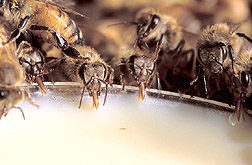| Read the
magazine
story to find out more.
|

A new diet that ARS researchers helped develop can
provide a nutritional boost to help keep honey bees healthy and productive.
Click the image for more information about it.
|

|
MegaBee Nourishes Beleaguered Honey Bees
By Marcia Wood
February 14, 2008 Bees busily ferrying pollen from
one cream-white almond blossom to another in California orchards this winter
might get some of their zip from a new food called
MegaBee: The Tucson Diet.
Agricultural Research Service (ARS)
entomologist
Gloria
DeGrandi-Hoffman created the research and development agreement that led to
this new, convenient source of proteins, vitamins and minerals that bees need
for good health. Bees can eat MegaBee as a meal or snack when days are too cold
for venturing outside of their warm hive, for example, or when
flowers—bearing pollen and nectar, the staple foods for adult
bees—aren't yet in bloom.
Better nutrition might be a key to reversing the decline of honey bees,
Apis mellifera, in the United States. A mostly mysterious
colony collapse
disorder is blamed for losses of once-thriving colonies, as are problems
caused by mites, beetles, Africanized honey bees, diseases and pesticides.
DeGrandi-Hoffman, at the
ARS
Carl Hayden Bee Research Center in Tucson, Ariz., sought the expertise of
Gordon
I. Wardell, entomologist and owner of S.A.F.E. R & D, LLC, in Tucson,
to develop a new, nutritious food for bees. The resulting MegaBee has now been
on the market for about six months. It's manufactured by
Castle Dome Solutions, LLC,
in Yuma, Ariz., and sold by Dadant & Sons,
Inc., of Hamilton, Ill., which supplies honey producers, beekeepers and
candlemakers.
Tests conducted in California by Wardell and ARS scientists in the winter of
2007 showed that bees ate MegaBee at about the same rate as natural pollen. But
MegaBee-fed bees helped produce more brood, or young, than did their pollen-fed
hivemates.
Ongoing research, in orchards and in laboratories at the Carl Hayden center,
should reveal even more about bees' year-round nutrition needs.
Nutrition investigations, a special emphasis at the Carl Hayden laboratory,
are part of a new, nationwide program of ARS-led scientific research on honey
bee health.
Read
more about this research in the February 2008 issue of Agricultural
Research magazine.
ARS is the U.S. Department of
Agriculture's chief scientific research agency.